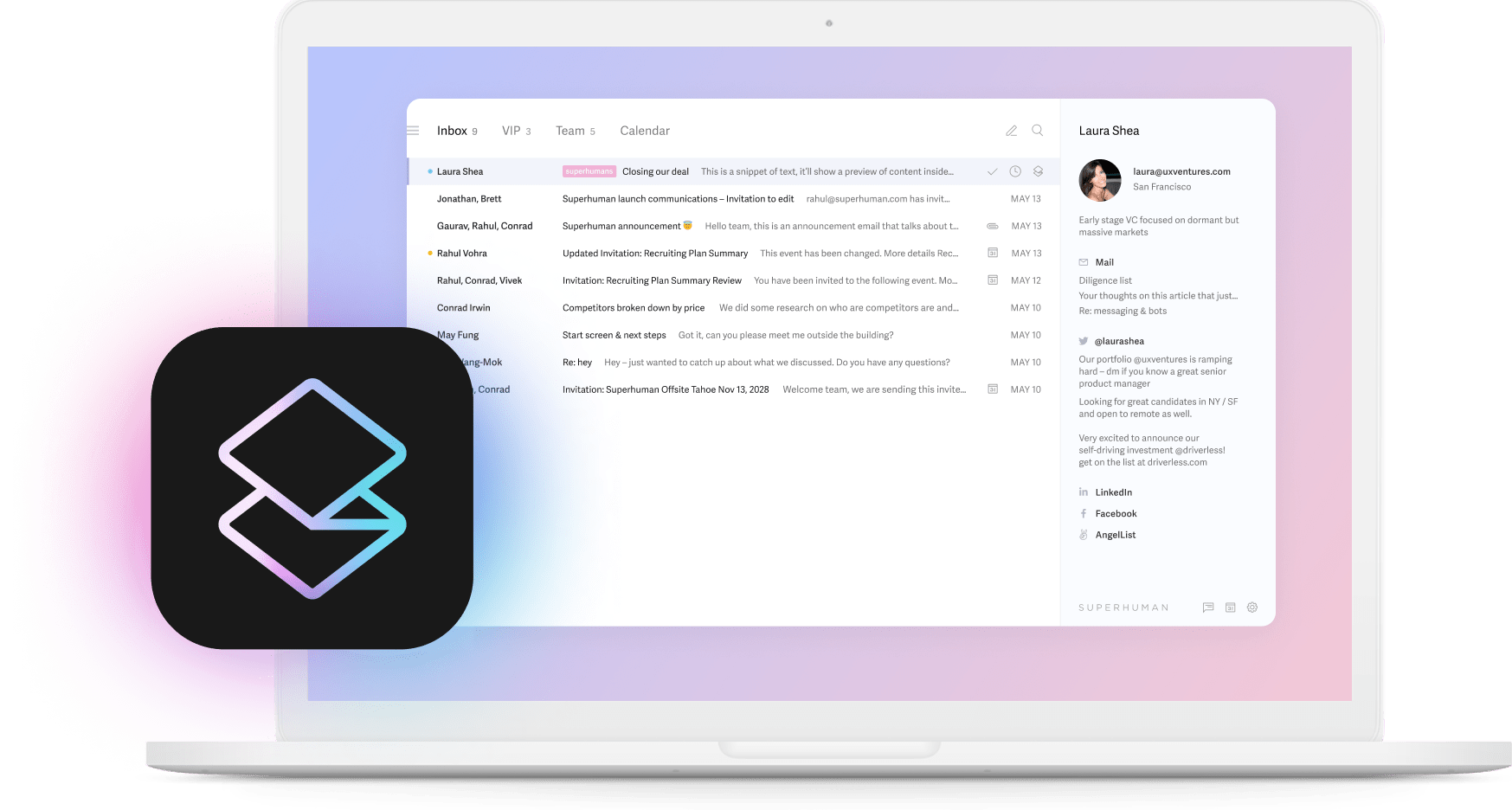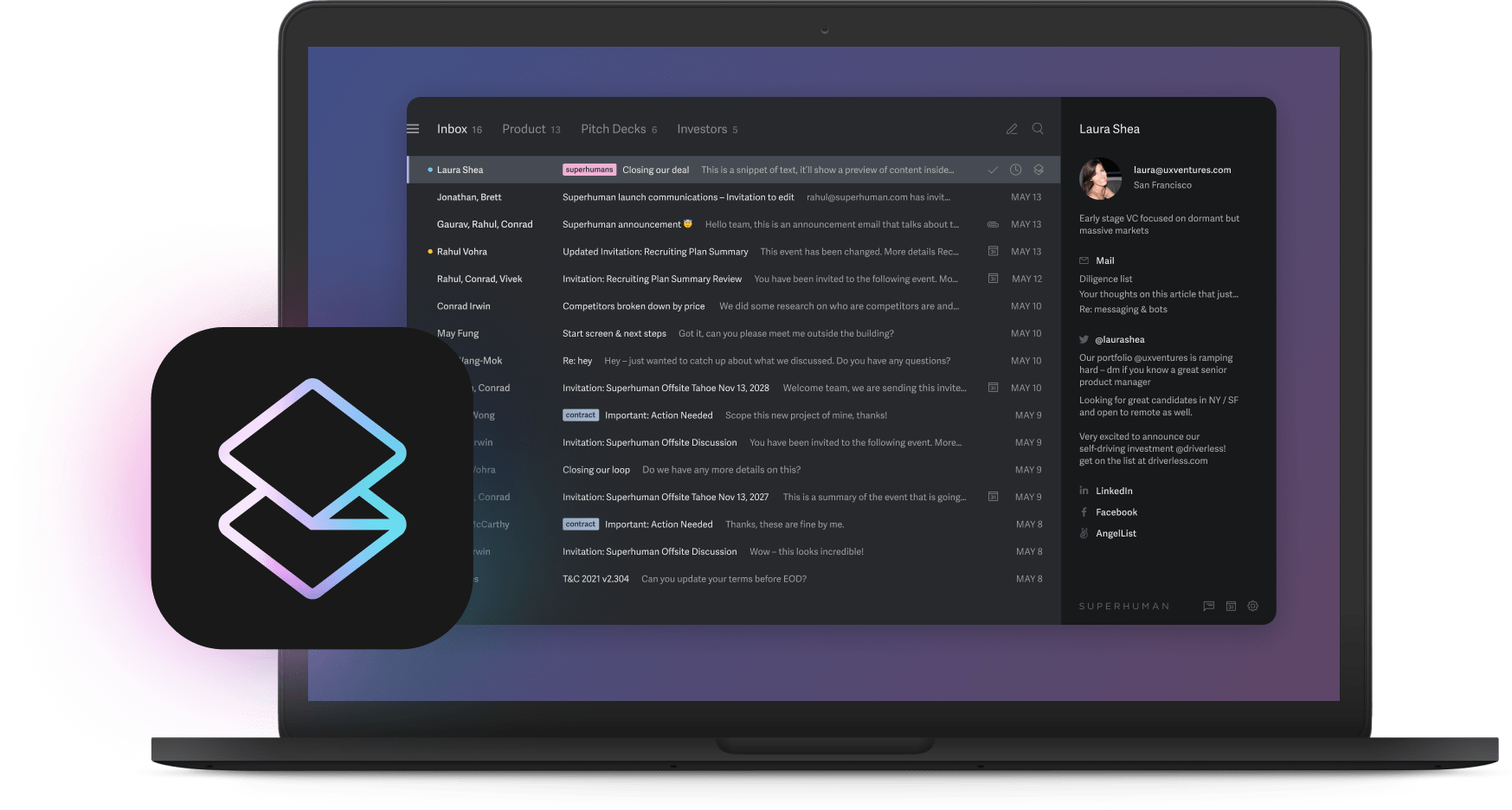
Most people spend the majority of their work week just dealing with email. That's like having a part-time job where all you do is move messages around. Companies lose tens of thousands of dollars per employee every year because everyone's stuck managing inboxes instead of doing real work.
So, what are the benefits of using AI for email management? The short answer: you get your life back. Teams using AI-native tools save 4 hours per week, which means they get to focus on work that matters.
What if your email sorted itself? What if replies wrote themselves in your voice? What if you never missed important messages because they got buried under newsletters? These transform email from a time sink into a productivity tool.
Benefit #1: Automatic email prioritization saves hours daily
Picture getting 300 emails every day. Your inbox looks like a tornado hit it. Important client messages get buried under random notifications and company newsletters. You spend your morning hunting for what matters instead of responding to it.
One of the biggest benefits of using AI for email management is automatic prioritization. AI reads every message and decides what deserves your attention. It analyzes sender importance, content urgency, and your historical response patterns. Then it organizes everything without you lifting a finger.
Instead of manually sorting through hundreds of emails, AI puts the important ones first. Client communications rise to the top. Newsletter subscriptions and automated notifications get filtered out. You end up processing email twice as fast because you're not hunting through junk to find what matters.
When executives can focus on high-priority communications first, they make faster decisions, respond to opportunities quicker, and maintain better relationships with key contacts.
Benefit #2: AI writing assistance maintains your voice at scale
You provide a few key points, and AI expands them into complete emails that sound exactly like you. Not generic robot responses, but communications that match your personal style and tone.
AI writing works by analyzing your previous emails to understand your communication patterns. How formal you get with different types of contacts, whether you prefer detailed explanations or brief summaries, and what phrases you use regularly. The system builds a model of your writing style and applies it consistently.
This solves a huge productivity problem. Most professionals spend way too much time crafting emails, especially when they need to sound professional and complete. With AI assistance, you can maintain high-quality communication without the time investment.
The consistency benefits are just as important as the speed. AI ensures your email format and tone remain professional across all communications. Whether you're rushing between meetings or writing late at night, your emails maintain the same quality standard.
For teams and businesses, this means better communication quality at scale. Sales teams can maintain personalized outreach without spending hours on each message. Customer service can provide thorough, helpful responses faster. Executives can handle larger volumes of communication without sacrificing quality.
Benefit #3: Smart search that understands context
You need that email from three weeks ago about the budget meeting. You remember it exists, but can't remember who sent it or what the subject line said. So you start scrolling through hundreds of messages, trying random keyword searches that don't work.
Traditional email search only finds exact word matches, which isn't how our brains work. AI search understands context and intent, not just specific words.
You can search for "that conversation about changing the project deadline," and AI finds the right thread even if those exact words weren't used. The system reads meaning, analyzes conversation topics, and connects related concepts. Like having a search engine that thinks like you do.
AI also excels at summarizing long email conversations. Instead of scrolling through 20 replies to understand what happened, AI can extract key decisions, action items, and next steps. You get the essential information without wading through the entire conversation history.
This transforms how you interact with your email archive. Instead of email history being this black hole where information disappears, it becomes an accessible knowledge base where you can find anything quickly.
Benefit #4: Automated follow-up tracking prevents dropped communications
You get an important email, read it, think "I'll reply to this later," and then completely forget about it. Three days pass. Maybe a week. When you finally remember, it feels awkward to respond.
One of the most valuable benefits of using AI for email management is solving this follow-up problem. Our brains aren't designed to remember tasks without immediate deadlines. But missing follow-ups costs real money, especially when relationships and deals are involved.
AI solves this by tracking every email that requires a response. The system knows when you've read something but haven't replied, understands which messages are time-sensitive, and reminds you before things get awkward.
AI reminders dramatically improve response rates. When systems prompt people to follow up, they do it. Sales teams see particularly strong benefits because timing matters so much in closing deals and maintaining prospect relationships.
Beyond just reminders, AI can help optimize follow-up timing. The system learns when different contacts are most likely to respond and suggests the best times to reach out.
When you consistently respond to people in reasonable timeframes, you build a reputation for reliability and professionalism that pays long-term dividends.
Benefit #5: Advanced spam and threat protection
Email threats are evolving rapidly. 51% of spam is now AI-generated, making it much harder to spot with traditional filters. These sophisticated attacks can fool even careful professionals.
Here's another critical benefit of using AI for email management: protection that evolves with threats. If attackers are using AI to create better scams, you need AI to detect better threats. Modern AI security systems don't rely on static rules that become outdated quickly.
Instead, AI learns patterns of suspicious activity. It analyzes email structure, sender patterns, content characteristics, and warning signs that humans would never notice. When something looks suspicious, even subtly, the AI catches it before it reaches your inbox.
Machine learning systems improve continuously. They encounter new attack types and learn to recognize similar threats in the future. This matters because scammers constantly develop new techniques. Static security rules can't keep up with this evolution, but learning systems can.
The protection extends beyond obvious spam to sophisticated phishing attempts, business email compromise attacks, and other targeted threats. For executives and teams handling sensitive information, this level of security becomes essential.
Modern AI security also reduces false positives. Traditional spam filters often block legitimate emails, but AI systems better understand context and legitimate communication patterns, so fewer important messages get incorrectly filtered.
Benefit #6: Enhanced team collaboration and coordination
Most teams still rely heavily on email for coordination, despite the proliferation of chat apps and project management tools. Email remains essential for formal communications, external coordination, and maintaining records of important decisions.
When people ask about the benefits of using AI for email management, team collaboration often gets overlooked. But AI transforms email from a coordination problem into an effective collaboration platform.
AI-enhanced email collaboration eliminates common problems like people being left out of important conversations, duplicate responses, and confusion about who's handling what. Smart threading and conversation management ensure everyone stays informed without information overload.
AI can also route emails to appropriate team members based on content and expertise. Customer inquiries get directed to the right departments automatically. Project-related communications get tagged and organized so nothing falls through the cracks.
The time savings from better email collaboration compound across teams. When communication flows more efficiently, decisions happen faster, projects stay on track, and less time gets wasted on coordination overhead.
For leaders, AI provides insights into how teams communicate that help improve team workflows. You can see where communication problems occur and address them proactively.
Benefit #7: Personalized communication at scale
Traditional mass email feels impersonal because it is impersonal. Companies blast the same generic message to thousands of people and wonder why response rates stay low. But writing truly personal emails to large numbers of people isn't practical without assistance.
Here's a transformative benefit of using AI for email management: maintaining personal communication quality even when reaching many people. AI analyzes how different contacts engage with your emails and personalizes messaging accordingly.
The system learns when different people typically read emails, what types of content they respond to, and what communication style works best with each contact. Then it helps you craft messages that feel personally written while maintaining efficiency.
This goes beyond simple mail merge personalization. AI can adjust tone, content depth, timing, and messaging approach based on individual recipient preferences and behaviors. Tools like Snippets enable quick creation of personalized messages while maintaining consistency. The result feels authentic because it's based on real interaction patterns.
For sales teams, this enables meaningful outreach at scale. For customer service, it allows personalized responses without a massive time investment. For any business communication, it maintains the human touch that builds relationships while operating efficiently.
The response rate improvements from AI personalization are substantial. Companies report significantly higher open rates, response rates, and conversion rates when using AI to personalize email communications at scale.
Benefit #8: Seamless workflow integration and automation
Most professionals juggle email alongside calendars, CRM systems, project management tools, and various other applications. Switching between these systems wastes time and creates opportunities for important information to fall through the cracks.
One of the most practical benefits of using AI for email management is seamless integration with existing workflows. AI connects email with other tools you already use, automatically sharing information and reducing manual data entry.
When emails relate to specific clients or projects, AI can automatically log them in the appropriate systems. Meeting requests get cross-referenced with calendar availability. Project communications get tagged and organized based on content. Contact information gets updated across systems automatically.
AI also enables intelligent scheduling by analyzing multiple calendars, understanding preferences, and suggesting optimal meeting times. The system does the coordination work that typically requires multiple back-and-forth emails.
This integration eliminates much of the manual work that makes email management time-consuming. Instead of copying information between systems or remembering to update records, AI handles the busy work automatically.
The time savings compound over time. Teams using integrated AI email systems report faster response times, fewer missed communications, and significantly less time spent on email-related busy work.
Benefit #9: Continuous learning and improvement
Unlike traditional email tools that remain static, AI email management systems continuously evolve and improve. The machine learning algorithms adapt to your communication patterns, learn from new situations, and become more effective over time.
When considering all the benefits of using AI for email management, this might be the most important long-term advantage: the system gets better at helping you the more you use it. AI learns your preferences, understands your communication style, and anticipates your needs more accurately.
This continuous improvement extends beyond individual optimization. AI systems learn from how people use them to identify new ways to help customers be more productive. Features that don't exist today become available as the AI discovers new optimization opportunities.
For businesses, this means the return on investment from AI email tools grows over time. Early adopters get immediate productivity benefits plus long-term advantages as the AI learns their specific workflows and optimizes accordingly.
The adaptability also helps future-proof email workflows. As communication patterns evolve and new challenges emerge, AI systems can adapt automatically rather than requiring manual reconfiguration or replacement.
Teams using AI email management report that their systems become more valuable over time, not less. The AI learns how teams communicate, improves workflows, and provides insights that help improve overall productivity and collaboration effectiveness.
Why the benefits compound over time
The real power of AI email management transforms your entire relationship with email. When prioritization, writing assistance, search, follow-up tracking, and integration all work seamlessly together, email stops being a productivity drain and becomes a competitive advantage.
Teams that adopt AI email management early report response times that are 12 hours faster than traditional email workflows. They handle twice as many communications in the same time and save significant hours every week that can be redirected to high-value work.
For leaders who want their teams to stay productive as email volume continues growing, AI tools provide the foundation for communication that scales effectively. These systems transform email from a necessary burden into a strategic asset that gets stronger and more effective over time.
Curious what productivity experts Efficient App love about Superhuman? Check out their Superhuman Review.






